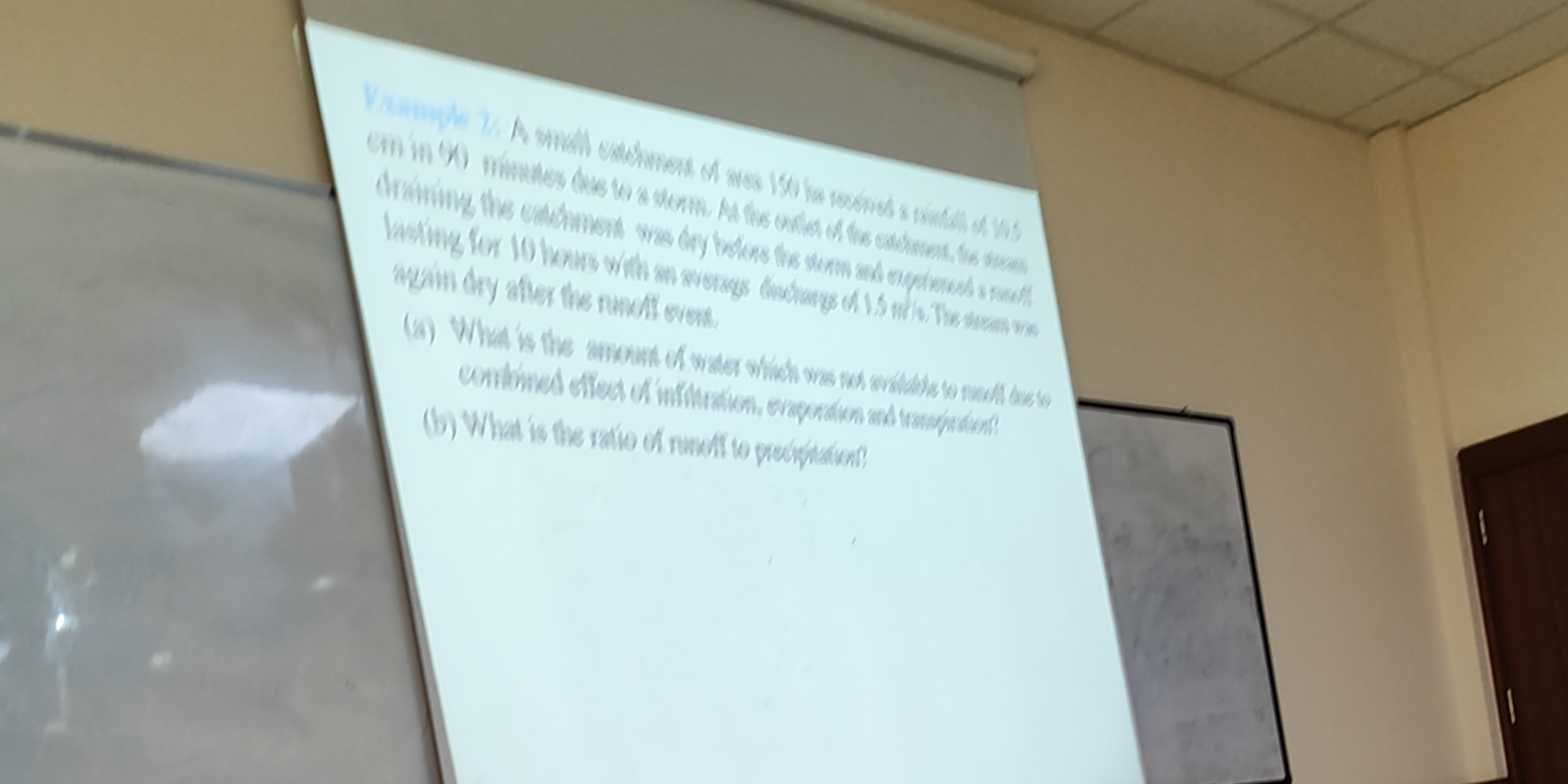A small catchment of area 150 ha received a rainfall of 10.5 cm in 90 minutes due to a storm. At the outlet of the catchment, the stream draining the catchment was dry before the s... A small catchment of area 150 ha received a rainfall of 10.5 cm in 90 minutes due to a storm. At the outlet of the catchment, the stream draining the catchment was dry before the storm and experienced a runoff lasting for 10 hours with an average discharge of 1.5 m³/s. The stream was again dry after the runoff event. (a) What is the amount of water which was not available to runoff due to the combined effect of infiltration, evaporation, and transpiration? (b) What is the ratio of runoff to precipitation?

Understand the Problem
The question involves a hydrological problem concerning a small catchment area. It provides details about rainfall, duration, and runoff discharge. Part (a) requires calculating the amount of water not available for runoff due to infiltration, evaporation, and transpiration. Part (b) asks for the ratio of runoff to precipitation.
Answer
(a) $1.035 \times 10^5 \text{ m}^3$ (b) $0.343$
Answer for screen readers
(a) The amount of water not available for runoff is $1.035 \times 10^5 \text{ m}^3$. (b) The ratio of runoff to precipitation is approximately $0.343$.
Steps to Solve
- Calculate total precipitation volume
First, convert the area from hectares to square meters: $$ 150 \text{ ha} = 150 \times 10^4 \text{ m}^2 = 1.5 \times 10^6 \text{ m}^2 $$ Convert the rainfall from centimeters to meters: $$ 10.5 \text{ cm} = 0.105 \text{ m} $$ Then, calculate the total volume of precipitation: $$ V_{precipitation} = \text{Area} \times \text{Rainfall} = (1.5 \times 10^6 \text{ m}^2) \times (0.105 \text{ m}) = 1.575 \times 10^5 \text{ m}^3 $$
- Calculate total runoff volume
Convert the runoff duration from hours to seconds: $$ 10 \text{ hours} = 10 \times 3600 \text{ s} = 36000 \text{ s} $$ Calculate the total volume of runoff using the average discharge: $$ V_{runoff} = \text{Discharge} \times \text{Duration} = (1.5 \text{ m}^3/\text{s}) \times (36000 \text{ s}) = 5.4 \times 10^4 \text{ m}^3 $$
- Calculate the volume of water not available for runoff
Subtract the runoff volume from the precipitation volume to find the volume of water not available for runoff: $$ V_{\text{not available}} = V_{precipitation} - V_{runoff} = (1.575 \times 10^5 \text{ m}^3) - (5.4 \times 10^4 \text{ m}^3) = 1.035 \times 10^5 \text{ m}^3 $$
- Calculate the ratio of runoff to precipitation
Divide the runoff volume by the precipitation volume to find the ratio: $$ \text{Ratio} = \frac{V_{runoff}}{V_{precipitation}} = \frac{5.4 \times 10^4 \text{ m}^3}{1.575 \times 10^5 \text{ m}^3} = 0.342857 \approx 0.343 $$
(a) The amount of water not available for runoff is $1.035 \times 10^5 \text{ m}^3$. (b) The ratio of runoff to precipitation is approximately $0.343$.
More Information
The ratio of runoff to precipitation is also known as the runoff coefficient.
Tips
A common mistake is not converting all units to the same system (e.g., hectares to square meters, centimeters to meters, hours to seconds) before performing calculations. Additionally, errors can occur in the arithmetic when handling large numbers in scientific notation.
AI-generated content may contain errors. Please verify critical information